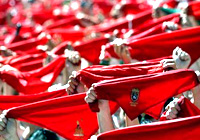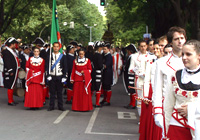Los Sanfermines, known for its Running of the Bulls and made famous around the world by Ernest Hemingway's novel, The Sun Also Rises, has gone from being a small, regional and hardly known provincial event, to becoming an international sensation that attracts thousands of visitors on a yearly basis, claiming a central place not only in the cultural calendar of the country, but also on its economic planning. So, this year, when the bulls make the rounds, why not join the masses and run along with them!
With Enforex, you can! Festivals provide wonderful opportunities to get to know a given city's culture and traditions, which is precisely why our schools are open all year round... yes, even during festival seasons! This year, why not come to Pamplona and learn Spanish during the Running of the Bulls? It's guaranteed to be an experience you'll never forget! Get more info about our Pamplona school, courses, accommodation and city guide at learn Spanish in Pamplona page.
While Los Sanfermines is a festival to be experienced in person, keep reading for more information about the history and traditions of this incredible celebration.
When and Where are Los Sanfermines?
The week-long festival starts on July 6, the eve of the Feast of Saint Fermin, with official and unofficial events taking place throughout the following week, until the grand finale, which arrives on July 14. Each day a different event takes center stage, and although the Running of the Bulls has become the quintessential symbol of the entire festival, it is actually with a simple session of daytime fireworks that the festivity is declared opened at noon of July 6. Processions are planned for the subsequent days, with an icon of the saint making the rounds on July 7, and giant figurines providing a unique local touch.
While the Running of the Bulls is not unique to the sanfermines of Pamplona, the most famous of the different events including encierros in northern Spain is certainly the one that takes place in Pamplona. Nevertheless, while it is true that towns throughout Navarre and the surrounding area have similar traditions in relation to bulls, the actual week-long festival, los sanfermines, paying tribute to Saint Fermin and involving many other activities is unique to this otherwise laid-back city, which for one week during the summer every year comes to life in an admirable and striking way.


Los Sanfermines Traditions
Los sanfermines kick into gear on July 6 with the txupinazo, when a rocket blasts off in front of the city hall to announce fiesta's commencement. This moment of deafening cheers and uncorked champagne bottles certainly sets the tone of the week, as the city dives headfirst into a week a crazed festivities.
The chaotic running of the bulls, or el encierro, is the most characteristic and internationally renowned part of the sanfermines. The running of the bulls takes place everyday at eight in the morning and consists of a crowd of primarily young men who run ahead of the clamoring bulls through an 830-meter stretch of cobbled road and into the city´s bullring.After each morning is greeted with the daily Running of the Bulls, bullfights liven up each afternoon, and parades featuring bands of music and enormous giants constantly wind through the streets. On July 7th, a procession dating back to the 13th century boasts music and enormous crowds as it passes through Pamplona in honor of San Fermín.
Every party must come to an end, and in the case of los sanfermines that inevitable moment is called the pobre de mí. The crowd laments the end of another year's festivities with the traditional song, the pobre de mí, literally meaning "poor me."
History of Los Sanfermines
Held annually since 1591, the weeklong festival celebrates Pamplona's son-turned-saint San Fermín. Living circa 3AD when Pamplona was part of the expansive Roman Empire, San Fermín learned of Christianity from the French bishop San Saturnino, who had come to Pamplona to spread the good word. San Fermín found himself so inspired that he travelled to France to study and eventually become a bishop himself.
That accomplished, he followed in San Saturnino's footsteps and took to the spreading of Christianity, but on one of his stops came up against some local powers in France who were quite opposed to the idea. Refusing to abandon his cause, San Fermín was beheaded and interred. However, part of his remains made their way back to his hometown of Pamplona, which made him quite popular in the city. So popular, in fact, that not long afterwards townspeople initiated an annual festival to honor him. How exactly that evolved into the nonstop week of partying and running of the bulls that it is today remains a mystery!




